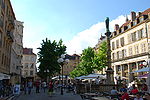Roman Catholic Diocese of Metz

The Diocese of Metz (Latin: Dioecesis Metensis; French: Diocèse de Metz) is a Latin Church ecclesiastical territory or diocese of the Catholic Church in France. In the Middle Ages it was a prince-bishopric of the Holy Roman Empire, a de facto independent state ruled by the prince-bishop who had the ex officio title of count. It was annexed to France by King Henry II in 1552; this was recognized by the Holy Roman Empire in the Peace of Westphalia of 1648. It formed part of the province of the Three Bishoprics. Since 1801 the Metz diocese has been a public-law corporation of cult (French: établissement public du culte). The diocese is presently exempt directly to the Holy See.
Excerpt from the Wikipedia article Roman Catholic Diocese of Metz (License: CC BY-SA 3.0, Authors, Images).Roman Catholic Diocese of Metz
Place Saint-Étienne, Metz Bellecroix
Geographical coordinates (GPS) Address Website Nearby Places Show on map
Geographical coordinates (GPS)
| Latitude | Longitude |
|---|---|
| N 49.1201 ° | E 6.17591 ° |
Address
Cathédrale Saint-Étienne
Place Saint-Étienne
57000 Metz, Bellecroix
Grand Est, France
Open on Google Maps










